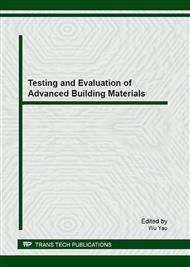p.1
p.5
p.10
p.14
p.19
p.25
p.30
p.35
p.40
Quantitative Characterization of Hydration of Cement Pastes by Rietveld Phase Analysis and Thermoanalysis
Abstract:
The quantitative characterization of hydration of cement pastes has always been one of focuses of researchers’ attention. Rietveld phase analysis (RPA), a combination of quantitative X-ray diffraction (QXRD) and the Rietveld method, supplies a tool of an enormous potential for that. Although a few of related researches were conducted by RPA, the reported attention was not paid to the neat cement paste with a low w/c ratio. Therefore, this work aimed at the quantitative study on hydration of such a cement paste chiefly by this method, meanwhile, cooperated with the hyphenated technique of thermogravimetry with differential scanning calorimetry (TG-DSC), as a spot check. Results indicated that RPA was a reliable method in quantitatively characterizing hydration of cement pastes, and gave a clear decription of evolution of all main crystal phases in cement pastes; and that the evolution of monosulphate(Afm_12) was also able to be tracked quantitatively. This will help to understand better the hydration mechanism of cement pastes, as well as to investigate quantitatively effects of mineral and chemical admixtures on hydration of composite cementitious systems.
Info:
Periodical:
Pages:
19-24
Citation:
Online since:
January 2013
Authors:
Price:
Сopyright:
© 2013 Trans Tech Publications Ltd. All Rights Reserved
Share:
Citation:


